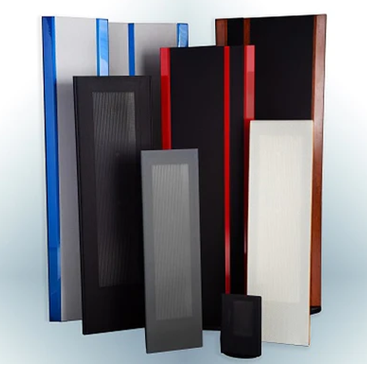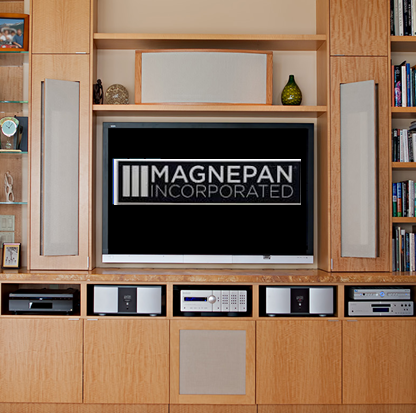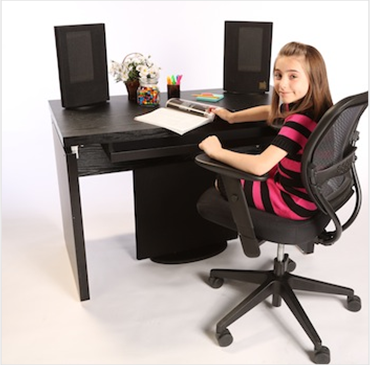Manual LRS
LRS Instruction Manual
Table of Contents
-
Quick Set-up
- Remove panels and feet from the carton. KEEP ALL PACKAGING! If you should ever return the speakers to Magnepan, they must be returned in their original carton. There will be a charge if it is necessary to replace packaging.
- Install the feet on the back of the speakers and tighten the screws. If the little flippers on the ends of the feet do not fall loosely by their own weight, spread their ends apart until the friction is eliminated.
- The LRS uses a unique high-current connector which accepts banana plugs or bare wire (See Figure 1). Strip approximately 1/4-inch of insulation from the speaker cable end and insert banana plug or wire into the connector and tighten the set screw with the Allen wrench provided. Special spade lug adapters are available from Magnepan...call to order. Magnepan encourages the use of large gauge speaker wire (preferably 16 gauge or larger). TO INSURE PROPER PHASING OF THE SPEAKERS, MAKE SURE PLUS (+) IS TO PLUS AND MINUS (-) IS TO MINUS.
- Your speakers come in matched pairs and are mirror-imaged. The serial number for each speaker in the pair is the same except a "1" or "2" follows each serial number. Place speaker "1" on the left and "2" on the right. This places the tweeters to the outside. Whether the tweeter is on the inside or outside, the tweeter should not be closer to the listener than the bass section. Measuring from your seated position, if the bass panel is 10 feet, 6 inches, the tweeter should be at least 10 feet, 7 inches (think in distance, not angles).
- Locate the speakers 2 feet or more in front of a wall.
- The distance between the speakers should be approximately 60% of the distance you will be from the speakers when you listen to them, for example: if you will be 10 feet from the speakers, position them about 6 feet apart.
- Tweeter attenuation-- The tweeter attenuator jumper provides maximum tweeter volume for heavily-damped rooms. Your room may require tweeter level reduction by inserting a resistor in place of the jumper.
-
CAUTION – CAUTION – CAUTION
- FUSING: The speaker terminal plate indicates a maximum fuse value of 4 amps — Type 3AG (“normal” or “fast blow”). As a precaution, your speakers have been shipped with 3 amp fuses installed. Never bypass, increase the value beyond 4 amps, or use “slow blow” fuses in these speakers. Our destruct tests indicate it is virtually impossible to burn out the tweeters if the above precautions are observed. NOTE: Burned out tweeters indicate abuse and are not covered by the warranty.
- CAT OWNERS: It has been reported that cats will sometimes use Magneplanars for scratching posts. Should you have this problem we suggest cat repellent from your local pet shop.
-
Fine Tuning
- BASS RESPONSE: If you do not have access to test equipment play a record or CD with a repetitive bass line. Try the speakers in several positions. Begin experimenting with the speakers approximately 3 feet from the wall. While listening to the repetitive bass, move the speaker forward and backward in increments of about 6 inches. You should notice positions where the bass is stronger or weaker. While trying different speaker placements, move around the listening area. You will notice the bass is stronger in some locations than others. This is due to standing waves in the room. You should locate your listening position and the speakers where the sound seems the most natural.
- TILT FEATURE: When sitting in a low chair or when seated more than 10 or 12 feet from the speakers, the speakers should be tilted forward for best frequency balance. To tilt the speakers forward, pull the top of the speaker forward to allow the flippers on the ends of the feet to drop down. To disengage the flippers simply pull the speaker forward or reach down and rotate the flipper over the top of the foot.
- STEREO IMAGING AND DEPTH: Once you have determined the best bass position, separate the speakers by 60% of the distance from your listening chair to the speakers. For example, if your chair is 10 feet from the speakers, move the speakers apart in increments of 3 or 4 inches, listening carefully at each position. At some point you will start to hear two separate speakers instead of a “stage effect.” If you have this “hole-in-the-middle” effect, your speakers are too far apart. Begin moving them back together in small increments until you notice a point at which you achieve one cohesive “sound stage.” Orchestral music is good for this adjustment.
- OPTIONAL TWEETER ATTENUATION: There are several reasons for possibly needing to attenuate the tweeters in the LRS:
- Recordings typically in the “pop” or “rock” vein often exhibit a pronounced rise in the treble region.
- The Magneplanar Quasi ribbon tweeter is very efficient in it’s total energy dispersion. If the surrounding walls are exceptionally reflective, the overall perceived acoustical balance can be tipped toward a “hot” high end.
- Put A and B together and it can be unbearable.
- Attenuation is accomplished by placing a resistor in the attenuation position on the connection plate (see Figure 1 on next page). Provided with your speakers are 1 and 2 ohm resistors for this purpose. These resistors will provide 1 to 4 dB of attenuation. If you continue to have a brightness problem you might consider room treatment.
- ROOM ACOUSTICS: A room that is overly “bright” or “alive” will usually give the sound a “blurred” or “confused” effect. It can also contribute to the brightness problem mentioned above. On the other hand an overly “dead” room usually robs the sound of the aliveness and inner detail that can make you “think you are there.” You can determine which type of room you have by doing what acoustical engineers do when they are without their test equipment—they walk around a room while making an occasional loud clap with their hands. If you do this at different locations in your room and listen to the sound that bounces back at you from the room boundaries, you can get a pretty good idea of what your room is like. If you hear a tailing “zing” after the loud clap, you can be quite certain you have a “bright” room and you may need to consider some type of wall treatment.

Figure 1
-
Specifications
Description Two-way Quasi Ribbon Frequency Response 50Hz to 22kHz Sensitivity 86dB, 2.83 Volts, 500Hz @1 Meter Impedance 4 Ohms Dimensions 14-1/2" X 48" X 1-1/4” Shipping Weight 40 lbs./pair


